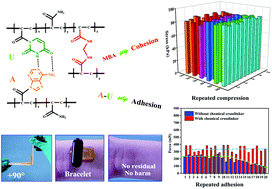Anti-fatigue adhesive and tough hydrogels regulated by adenine and uracil†
Abstract
Hydrogels generally possess either high strength or excellent adhesive behavior but not both, which limits their applications. Here, we present anti-fatigue, adhesive and tough hydrogels through introducing nucleobase pairs of adenine–uracil (A–U) and chemical crosslinkers of N,N′-methylene bis-acrylamide (MBA) into polyacrylamide hydrogels. The synergetic interaction of A–U and MBA endowed hydrogels with high mechanical performance and excellent adhesive behavior via the tunable balance of cohesion and adhesion. The hydrogels exhibited a tensile strength of 120 kPa, a superior stretchability of 2700%, and remarkable adhesive behavior for various materials and biological tissues, including wood, steel, copper, polytetrafluoroethylene, plastics, glass, rubber, silica rubber, spleen, liver and fat. For example, the adhesion strength of hydrogels at the surface of polytetrafluoroethylene was 190 N m−1. More importantly, the hydrogels exhibited excellent anti-fatigue compressive toughness and adhesiveness. It was envisioned that the nucleobase-tackified chemical crosslinking hydrogels with excellent anti-fatigue, tough and adhesive behavior would be widely applied in wound dressings, human wearable devices and biomedical sensors and electrodes.



 Please wait while we load your content...
Please wait while we load your content...